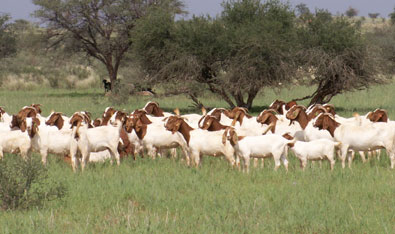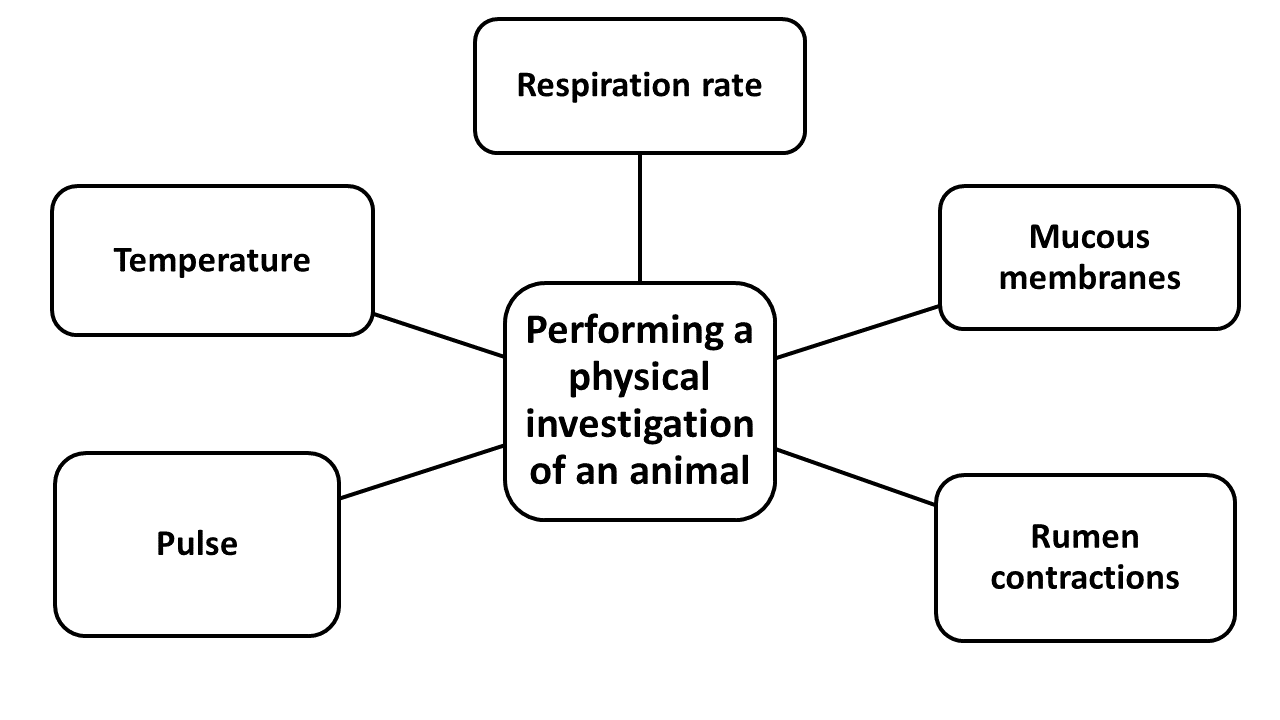Knowledge of the anatomy and physiology of the farm animal will allow the farmer to recognise when animals are not doing well. It must be remembered that the farmer who spends a lot of time with his animals will know their habits and appearance better, and will be able to spot any unusual behaviour or anatomical differences, which could possibly indicate a sick animal.
In a natural, undisturbed state, some animals will usually be eating, some will be lying and chewing their cud, some will be sleeping, but if one or more are lying in a corner of the field, kicking and struggling, you can be sure that they are in some sort of trouble.

If a few goats lag behind the rest of the group while herding them to a new camp, a closer look should be taken at the slower ones. It is important to know the big picture here, because heavily pregnant animals have a tendency of lagging behind and that is normal.
- Compare the sick animal to the rest of the group – are the others in the same state as it or not. If one animal is in a poorer condition than the others, there may be a problem.
- Consider the conditions under which the animals are managed. What have they been eating? What season is it? How old are they? Are they pregnant? Are they nursing young?
- Animals are just as susceptible to external factors as humans. There are some situations which lend themselves to the identification of a sick animal in your flock, e.g.
- Observing the flock in an undisturbed state
- While herding the animals
- During the regular inspections in the crush
Monitoring and Evaluating the Anatomy of an Animal
An examination of an under-performing animal should be done systematically and thoroughly, e.g. from top to bottom, and then from left to right.
Look at the head of the animal. Does it have a nasal discharge? Are its eyes clear and alert? Are there cuts or injuries? Are there any swellings? Is the head held normally, or drooping or bent down? Are the eyes bright, clear, and shiny, or are they red, opaque, or weeping? Are the ears alert or drooping? Is there frothing at the mouth or an excess of saliva? Are the mucous membranes around the eye pale, yellow, blue, or dark red?
Examine the animal’s neck. Are there any abscesses? Is there a swelling (oedema) under the jaw? Open wounds? Are the lymph nodes swollen?
The back. Is the back level and sturdy? Does it sag excessively? Is the coat in good condition? Shiny or dull? Does the animal have dandruff? Are there mites or lice? Are there bite marks or lick marks on the coat? Are there patches of hair missing? Is the skin loose or tight, soft or hard?
Rump. Are the hip-bones sticking out excessively? Do a condition scoring.
Shoulder. Are there any cuts, bruises, etc?
Ribcage. Are the ribs well covered with flesh? Are they moving rapidly, shallowly, and hardly at all?
Rumen and intestines. Can you hear any rumen movement (gurgles)? When you palpate the rumen is it hard, or floppy? Is the rumen bloated?
Reproductive organs (male and female). Check for ticks around all reproductive organs. If a female: is there a vaginal discharge? Is the vulva swollen and red? Is the ewe in pain when she urinates? If a male: are the testicles the same size? Is the penis normal, does it have sores? Is the prepuce infected?
Front limbs. Are the legs stiff? Is the animal lame?
Hind limbs. Are the legs stiff? Is the animal lame?
Hooves. Are they the right length? Are there any ticks between the hooves? Does the animal have any infections between the hooves?
Is the animal by itself, or with the rest of the herd/flock? Is it alert, or dull and unresponsive? Is it breathing normally? Is it coughing? Is it shivering? Is it eating and drinking normally? Is it ruminating normally?
Is it standing up or lying down? Is it lying normally?
Examine the faeces and urine. Are the faeces normal or abnormal (is there diarrhoea, mucous or blood)? Is the urine pale yellow, brown or red? Does the animal strain to pass urine or faeces?
Recognise pain in the animal. Is the animal bellowing or bleating? Is the animal restless? Does it grind its teeth? Is it grunting? Is it licking a lot? Is it kicking itself, if so, where?
What to look for in lactating animals. Are either or both teats inflamed, swollen, and tender? Are the teats injured? Does the milk contain milk clots? Is the milk blood-stained? Has the milk yield fallen?
Performing a Physical Investigation of an Animal
Respiration rate: Count the number of chest movements made per minute when the animal is at rest. Normal values for goats are 10 – 20 per minute. Young and old goats have slightly higher respiration rates than normal.
Pulse: Place a hand over the heart area, just under the left elbow, and count the heart beats: alternatively, there is an artery that can be felt on the inside surface of the thigh. Measurements must be taken when the animal is at rest. Normal values for goats are 60 – 80 per minute.
Temperature: The thermometer should be inserted through the anus into the rectum in a slightly upwards direction, and held for at least one minute. The normal temperature range for goats is 38.0 – 40.5 degrees Celsius.
Mucous membranes: Observe the lining inside the eyelids and mouth. If it is pale, the animal is anaemic, probably from gastrointestinal parasites or blood parasites. If it is yellow, there is a liver problem.
Rumen contractions: Place the palm of your hand firmly in the depression behind the last rib on the left and leave it for two minutes. Normal contractions can be felt at a rate of 1 – 2 per minute.
